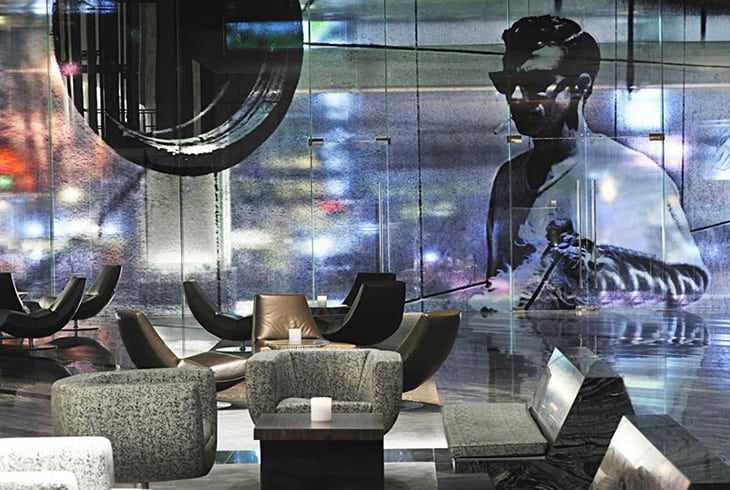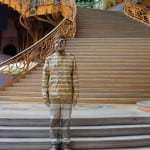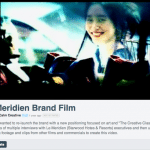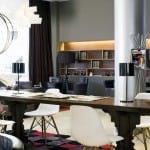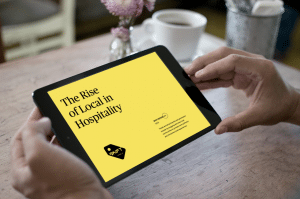Skift Take
Starwood Hotels developed a new brand story for its Le Méridien flag with a reworked social lobby concept, artistic collaborations, cool cultural events and a global group of cultural innovators.
- Homepage of the Unlock Art film series produced by Tate Museum, London
- Actor Alan Cumming in Pop Art-themed Unlock Art film
- Actress Sally Phillips in Art Fair-themed Unlock Art film
- Performance art at Tate Museum’s Unlock Art webpage
- Filters of Discovery Instagram promotion
- Jerome Sans (L), Le Méridien’s Global Cultural Curator
- LM100 member Kiki Allgeier (L) in Xiamen, China
- Le Méridien branding video by Cool Calm Creative
- LM100 Podcasts for the Creative Mind
- Rana & Richard Florida, author of “The Rise of the Creative Class”
- Louis Vuitton/Fendi photo shoot at Le Méridien Koh Samui
- The Hub at Le Méridien Bangkok
- The Hub at Le Méridien Barcelona
- The Hub at Le Méridien Barcelona
- The Hub at Le Méridien Abu Dhabi
- The Hub at Le Méridien Brussels
- The Hub at Le Méridien Oran
- The Hub at Le Méridien Chiang Mai
- The Hub at Le Méridien Atlanta Perimeter
- The Hub at Le Méridien Delfina Santa Monica
When Pop Art arrived on the scene in the 1950s, there were two kinds: Pop Art made in America about America, and Pop Art made in Britain about America. Some influential art critics like Clement Greenberg weren’t exactly fans, however, calling artists like Andy Warhol “superficial.” Warhol corrected him, saying his work was “deeply superficial.”
That’s the kind of thing you’ll learn in the latest installment of an eight-part film series called “Unlock Art,” developed by London’s Tate Museum in collaboration with Le Méridien Hotels. The films explain the historical and commercial precedents for contemporary art’s development with a whimsical, plain-speak delivery, offering a surprisingly indepth yet easily digestible overview of modern art.
The Tate programming is emblematic of a multi-billion dollar repositioning of the Le Méridien brand by parent company Starwood Hotels. The thrust of the rebranding targets creative professionals in different age demos seeking something less flashy than its sister brand, W Hotels. It’s accomplishing that through three branding pillars celebrating arts and culture:
- Unlock Art: Hotel partnerships with major cultural institutions worldwide
- LM100: An advisory group of international cultural/academic innovators
- “The Hub” lobby concept: “A Gathering Place for Creative Minds”
The repositioning methodology up to this point drills down into the very DNA of Starwood’s brand-building machinery.
Le Méridien was something of an enigma in Starwood’s portfolio after the company purchased the fledgling Paris-based flag in 2005. All of the other Starwood brands were clearly delineated in the marketplace, but Le Méridien needed grooming to align it with 21st century travel trends. The challenge: What do you do with a hotel brand—initially developed by Air France—with a great provenance, but one still languishing in the 20th century? And how do you differentiate it within the overall portfolio of brands?
The answers to those questions begin with the W Hotels story. Inspired by the “lobby socializing” trend popularized by boutique hotels in the early 1990s, W jumped on the phenomenon with its own “Living Room” lobby concept in the late 90s. Suddenly it was cool to hang out in a corporate hotel lobby. The execution was so successful that Starwood reproduced the model again, twice. “The Hive” lobbies at Westin Hotels focus on well-being with an eco/spa-themed consciousness. At Sheraton Hotels, the “Link@Sheraton” product is a computer/desk workspace that integrated the traditional hotel business office into public spaces skirting the lobbies.
The social dimension of each is obvious with names like Living Room, Hive and Link. Continuing with that theme, The Hub lobby design experience at Le Méridien includes communal tables, a coffee bar, edgy art/photography books, local art, trendy furnishings, cultural events, and other muses for upwardly mobile creative types. The overarching proposal is to educate curious, connected Starwood clients about more cultivated things to do in each Le Méridien destination.
“We aim to provide a new perspective to our guests through a curated approach to culture,” says Brian Povinelli, global brand leader for Le Méridien. Speaking about the Tate Museum partnership, he says the goal is to “unlock the world of contemporary art for more people.”
In addition, Starwood is pumping $3 billion into new Le Méridien hotels and upgrades worldwide, with another $1 billion influx of capital coming from hotel owners. On Le Méridien’s hotel destination page, 25 hotels are in the development pipeline from Charlotte to Shanghai.
Unlocking Le Méridien
Le Méridien’s Unlock Art program begins with the hotel room keys. Aside from opening doors, they serve as complimentary guest passes to local cultural venues such as Tate Modern for guests booking Le Méridien Piccadilly in London. In the U.S., similar pairings include the new Le Méridien Delfina Santa Monica and Santa Monica Museum of Art; the new Le Méridien Atlanta Perimeter and Spruill Center for the Arts; and Le Méridien Cambridge-MIT with MIT Museum.
The London film series is presently taking place over a period of eight months, with a new film released one month at a time. The first film is hosted by comedian Frank Skinner, who discusses the evolution of performance art. In the second film, actress Sally Phillips walks us through the world’s major art fairs while shedding light on the nebulous world of high-end art dealing. In the third, comedic actor Alan Cumming discusses the background of artists such as Warhol and Hockney, and artworks like Lichtenstein’s famous Whaam! fighter pilot cartoon painting.
The humor, celebrity and conversational tone of Skinner, Phillips and Cumming go a long way into making these films engaging and educational for the art layperson.
“Our goal is to promote public understanding and enjoyment of British, modern and contemporary art,” says Marc Sands, director of media/audiences at Tate. “[The films] offer an entertaining, thought-provoking yet witty approach to art…. We want to connect people who might not have considered some of the subjects before with contemporary art.”
The next installment in the series examines the role of women in art, airing January 24.
LM100: The Creative Types
The LM100 community of creative industry leaders and brand advocates brought together to enhance the guest experience at Le Méridien’s properties worldwide. The group consists of painters, photographers, musicians, designers, chefs, architects and other creative disciplines who provide Le Méridien with a single network for updates on global cultural trends.
The LM100 initiative has been under development in various guises since 2007 but there’s a new energy behind it of late. In September, Le Méridien and Travel + Leisure collaborated on an Instagram promotion called Filters of Discovery. LM100 photographers Naomi Atkinson, Dan Rubin and Ali Jardine—with over one million followers between them—were tasked to take Instagram photos during 72 hours in San Francisco, Paris and New Delhi. Both Le Méridien and T+L crowdsourced ideas for photo subjects from their social media followers, who were also asked to submit their own photos with the #LMfilters hashtag.
“Collectively the photos form a visual itinerary, an artful tapestry of what is possible to see, do, taste and experience over the course of three days in each city,” reads the project’s landing page.
Earlier this year, LM100 member and NYC-based professional filmmaker Kiki Allgeier explored Xiamen, Shanghai and Chongqing with local artists to create a short film about evolving lifestyle trends in China. It was also designed to provide exposure for Xiamen. Allgeier says she wanted to chronicle “a new perspective on modern China, discovering the hopes and dreams of the young generation and the growing importance of art and creativity in the local culture.”
In Xiamen, Le Méridien’s Unlock Art partnership is with the piano museum on Gulangyu Island.
New Perspectives: Richard Florida & Co
Jerome Sans, Le Méridien’s Global Cultural Curator, developed the Xiamen project as part of the hotel brand’s “New Perspective Events” series, promoting the role of Le Méridien hotels and resorts as creative community hubs.
“Le Méridien is more than simply a place to stay, but also an inspiration, unlocking a world of interactive art and cultural experiences in each unique destination,” he explains.
The poster child of the Creative Class is Richard Florida, author of The Rise of the Creative Class, who is a member of LM100. He and Sans have participated in a series of panel discussions with themes ranging from “Where Does Diversity in the Creative Class Fit into China?” to “What is Technology’s Impact on Human Interactions in the Workplace?”
In another entitled “Is Creativity Just for the Wealthy?,” Florida suggests that corporate funds for building creativity incubators are best dispersed in schools, where youth of all ages and economic classes can learn about new technology and synergies between corporations and artists.
“I think one of the things we can begin to teach is how creative people can learn to respect management and execution,” he says. “And how business and management people can begin to respect creativity.”
For more from Richard Florida and his wife Rana about how they’re helping Le Méridien’s hotels strengthen their roles as community hubs, watch this video. For recordings from many other LM100 members, visit Le Méridien’s Podcasts for the Creative Mind.
Digital User Experience Needs Work
The website for Tate Museum’s Unlock Art film series is impressive in terms of content and user experience. Aside from the excellent visuals and clear information architecture, each segment offers ancillary examples of artwork around the world relating to the theme of each film.
The Le Méridien corporate site is a different story. For viewers interested in exploring all of the artistic developments and cultural collaborations in each destination, the portal lacks the drama and comprehensive breadth of experience the content deserves. Understanding that Le Méridien’s site needs to align in design and operation with the other Starwood sites, there’s a solid business case here to create a robust, permanent individual website highlighting all of the creative innovation globally.
With so much emphasis on the hotels being cultural hubs in their specific destinations, a digital cultural hub anchors that message during the hotel search process. Le Méridien has an opportunity to cull everything its hotel associates and creative partners are learning and developing into one place. The resulting wealth of knowledge has the potential to be a torchbearer for Richard Florida’s idea of a new era where corporations and creatives collaborate more effectively to drive business on both sides of the equation.
As the iconic ad man David Ogilvy one wrote, “If it doesn’t sell, it isn’t creative.”
Greg Oates covers hospitality trends and next generation hotels. He has participated in 1,000+ hotel site inspections in over 50 countries.
Have a confidential tip for Skift? Get in touch
